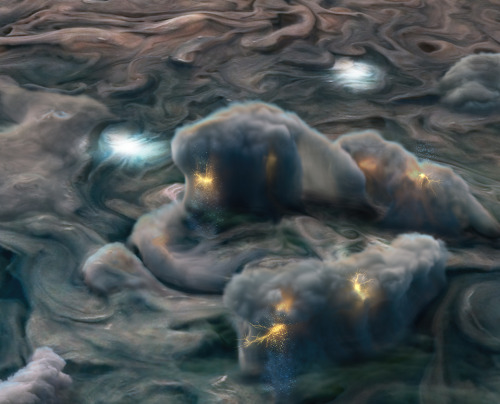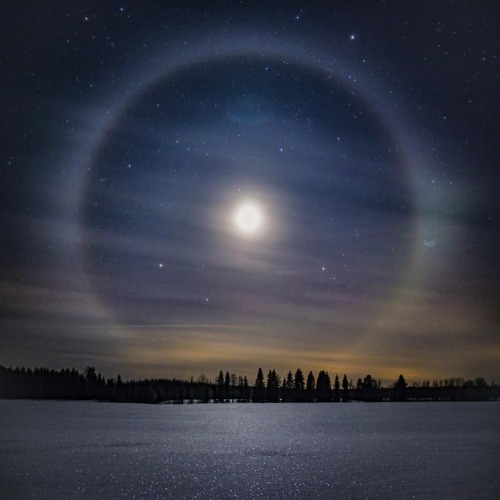Weird Magnetic Behavior In Space
Weird Magnetic Behavior in Space
In between the planets, stars and other bits of rock and dust, space seems pretty much empty. But the super-spread out matter that is there follows a different set of rules than what we know here on Earth.
For the most part, what we think of as empty space is filled with plasma. Plasma is ionized gas, where electrons have split off from positive ions, creating a sea of charged particles. In most of space, this plasma is so thin and spread out that space is still about a thousand times emptier than the vacuums we can create on Earth. Even still, plasma is often the only thing out there in vast swaths of space — and its unique characteristics mean that it interacts with electric and magnetic fields in complicated ways that we are just beginning to understand.

Five years ago, we launched a quartet of satellites to study one of the most important yet most elusive behaviors of that material in space — a kind of magnetic explosion that had never before been adequately studied up close, called magnetic reconnection. Here are five of the ways the Magnetospheric Multiscale mission (MMS) has helped us study this intriguing magnetic phenomenon.
1. Seeing magnetic explosions up close
Magnetic reconnection is the explosive snapping and forging of magnetic fields, a process that can only happen in plasmas — and it’s at the heart of space weather storms that manifest around Earth.
When the Sun launches clouds of solar material — which is also made of plasma — toward Earth, the magnetic field embedded within the material collides with Earth’s huge global magnetic field. This sets off magnetic reconnection that injects energy into near-Earth space, triggering a host of effects — induced electric currents that can harm power grids, to changes in the upper atmosphere that can affect satellites, to rains of particles into the atmosphere that can cause the glow of the aurora.

Though scientists had theorized about magnetic reconnection for decades, we’d never had a chance to study it on the small scales at which it occurs. Determining how magnetic reconnection works was one of the key jobs MMS was tasked with — and the mission quickly delivered. Using instruments that measured 100 times faster than previous missions, the MMS observations quickly determined which of several 50-year-old theories about magnetic reconnection were correct. It also showed how the physics of electrons dominates the process — a subject of debate before the launch.
2. Finding explosions in surprising new places
In the five years after launch, MMS made over a thousand trips around Earth, passing through countless magnetic reconnection events. It saw magnetic reconnection where scientists first expected it: at the nose of Earth’s magnetic field, and far behind Earth, away from the Sun. But it also found this process in some unexpected places — including a region thought to be too tumultuous for magnetic reconnection to happen.
As solar material speeds away from the Sun in a flow called the solar wind, it piles up as it encounters Earth’s magnetic field, creating a turbulent region called the magnetosheath. Scientists had only seen magnetic reconnection happening in relatively calm regions of space, and they weren’t sure if this process could even happen in such a chaotic place. But MMS’ precise measurements revealed that magnetic reconnection happens even in the magnetosheath.

MMS also spotted magnetic reconnection happening in giant magnetic tubes, leftover from earlier magnetic explosions, and in plasma vortices shaped like ocean waves — based on the mission’s observations, it seems magnetic reconnection is virtually ubiquitous in any place where opposing magnetic fields in a plasma meet.
3. How energy is transferred
Magnetic reconnection is one of the major ways that energy is transferred in plasma throughout the universe — and the MMS mission discovered that tiny electrons hold the key to this process.
Electrons in a strong magnetic field usually exhibit a simple behavior: They spin tight spirals along the magnetic field. In a weaker field region, where the direction of the magnetic field reverses, the electrons go freestyle — bouncing and wagging back and forth in a type of movement called Speiser motion.

Flying just 4.5 miles apart, the MMS spacecraft measured what happens in a magnetic field with intermediate strength: These electrons dance a hybrid, meandering motion — spiraling and bouncing about before being ejected from the region. This takes away some of the magnetic field’s energy.
4. Surpassing computer simulations
Before we had direct measurements from the MMS mission, computer simulations were the best tool scientists had to study plasma’s unusual magnetic behavior in space. But MMS’ data has revealed that these processes are even more surprising than we thought — showing us new electron-scale physics that computer simulations are still trying to catch up with. Having such detailed data has spurred theoretical physicists to rethink their models and understand the specific mechanisms behind magnetic reconnection in unexpected ways.

5. In deep space & nuclear reactions
Although MMS studies plasma near Earth, what we learn helps us understand plasma everywhere. In space, magnetic reconnection happens in explosions on the Sun, in supernovas, and near black holes.
These magnetic explosions also happen on Earth, but only under the most extreme circumstances: for example, in nuclear fusion experiments. MMS’ measurements of plasma’s behavior are helping scientists better understand and potentially control magnetic reconnection, which may lead to improved nuclear fusion techniques to generate energy more efficiently.

This quartet of spacecraft was originally designed for a two-year mission, and they still have plenty of fuel left — meaning we have the chance to keep uncovering new facets of plasma’s intriguing behavior for years to come. Keep up with the latest on the mission at nasa.gov/mms.
Make sure to follow us on Tumblr for your regular dose of space: http://nasa.tumblr.com
More Posts from Sidusglacies and Others









Space angel stimboard!
[x/x/x/x/x/x/x/x/x]
Photography by seanenmiddleton! please support the original post!

“One of the most actively changing areas on Mars are the steep edges of the North Polar layered deposits. This image from NASA’s Mars Reconnaissance Orbiter (MRO) shows many new ice blocks compared to an earlier image in December 2006. An animation shows one example, where a section of ice cliff collapsed. The older image (acquired in bin-2 mode) is not as sharp as the newer one.” Credit - nasa.gov

New results from our Juno mission suggest the planet is home to “shallow lightning.” An unexpected form of electrical discharge, shallow lightning comes from a unique ammonia-water solution.
It was previously thought that lightning on Jupiter was similar to Earth, forming only in thunderstorms where water exists in all its phases – ice, liquid, and gas. But flashes observed at altitudes too cold for pure liquid water to exist told a different story. This illustration uses data obtained by the mission to show what these high-altitude electrical storms look like.
Understanding the inner workings of Jupiter allows us to develop theories about atmospheres on other planets and exoplanets!
Illustration Credit: NASA/JPL-Caltech/SwRI/MSSS/Gerald Eichstädt/Heidi N. Becker/Koji Kuramura
Make sure to follow us on Tumblr for your regular dose of space: http://nasa.tumblr.com


love talking about weather. like yes girl the heat or lack thereof ❤️

A moon halo created by ice crystal in the air

Ben Lewis Giles - Astronaut, date unknown

Neighboring planets, painted by Don Dixon, 1978.
-
 mountaingoat0112 liked this · 3 months ago
mountaingoat0112 liked this · 3 months ago -
 badass-dora-milaje liked this · 1 year ago
badass-dora-milaje liked this · 1 year ago -
 lamiacasetta liked this · 1 year ago
lamiacasetta liked this · 1 year ago -
 renatocarvalho liked this · 1 year ago
renatocarvalho liked this · 1 year ago -
 brandon1997 liked this · 1 year ago
brandon1997 liked this · 1 year ago -
 demichrising liked this · 1 year ago
demichrising liked this · 1 year ago -
 emibertachini liked this · 1 year ago
emibertachini liked this · 1 year ago -
 mountain-crazed-snead liked this · 1 year ago
mountain-crazed-snead liked this · 1 year ago -
 crookedbouquetchopshop liked this · 1 year ago
crookedbouquetchopshop liked this · 1 year ago -
 vermilionvexation liked this · 1 year ago
vermilionvexation liked this · 1 year ago -
 mangiswig reblogged this · 1 year ago
mangiswig reblogged this · 1 year ago -
 mangiswig liked this · 1 year ago
mangiswig liked this · 1 year ago -
 alieba liked this · 1 year ago
alieba liked this · 1 year ago -
 glittering-under-the-glass liked this · 1 year ago
glittering-under-the-glass liked this · 1 year ago -
 4s14 liked this · 1 year ago
4s14 liked this · 1 year ago -
 randomaj liked this · 1 year ago
randomaj liked this · 1 year ago -
 scifidancer liked this · 2 years ago
scifidancer liked this · 2 years ago -
 suffer-for-supper liked this · 2 years ago
suffer-for-supper liked this · 2 years ago -
 dogasunder reblogged this · 2 years ago
dogasunder reblogged this · 2 years ago -
 solarboyaaron liked this · 3 years ago
solarboyaaron liked this · 3 years ago -
 saj-ish liked this · 3 years ago
saj-ish liked this · 3 years ago -
 nevermore-was-here liked this · 3 years ago
nevermore-was-here liked this · 3 years ago -
 bewareofdragon liked this · 3 years ago
bewareofdragon liked this · 3 years ago -
 willyoshi67 reblogged this · 3 years ago
willyoshi67 reblogged this · 3 years ago -
 willyoshi67 liked this · 3 years ago
willyoshi67 liked this · 3 years ago -
 th3mb0 liked this · 3 years ago
th3mb0 liked this · 3 years ago -
 sexual-engineer01 liked this · 3 years ago
sexual-engineer01 liked this · 3 years ago -
 mathlover00 liked this · 3 years ago
mathlover00 liked this · 3 years ago -
 sidusglacies reblogged this · 3 years ago
sidusglacies reblogged this · 3 years ago -
 kdsarge liked this · 4 years ago
kdsarge liked this · 4 years ago -
 thewitchstef liked this · 4 years ago
thewitchstef liked this · 4 years ago -
 corposeco liked this · 4 years ago
corposeco liked this · 4 years ago

